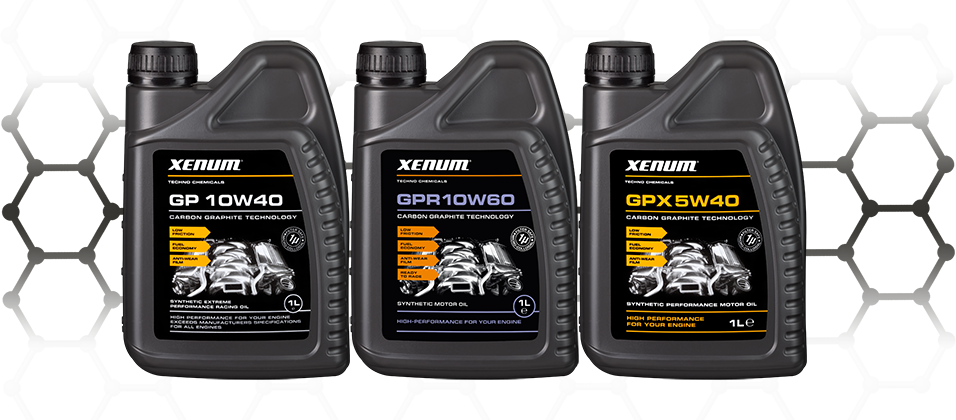Solid lubricants 3: Graphite oil and additives
(固態潤滑劑3:石墨機油及添加劑)
We have already covered two of the four most-used dry lubricants: MoS2 and Teflon. In this article we’re going to discuss the benefits and uses of a third one, graphite, and its use at Xenum in graphite oils and additives.
我們已經討論了四種最常見的乾式潤滑油其二的:MoS2 及 Teflon。在這次的文章裡,我們要討論第三種”石墨”的優點及使用,它使用在Xenum的石墨機油及添加劑中。
Solid advantages (固態的優點)
This crystalline semimetal is the most stable form of carbon (C) in standard conditions. Graphite is extremely popular in many industries thanks to its combination of metallic and nonmetallic properties. It is both a thermal and electrical conductor while also having great lubricity and high thermal resistance.
在標準狀況下,這個結晶半金屬是碳(C)中最穩定的。石墨在許多工業應用中相當相當受歡迎,多虧它金屬及非金屬屬性結合的特質。它能耐熱且為導電體,同時有很好的潤滑性及高耐熱性。
Alongside molybdenum, graphite is the most used solid lubricant so it is easy to make a comparison of the two. However, each one has its own uses.
除了鉬,石墨是很常被應用的固態潤滑體,所以兩者很常被做比較。
然而,各有各的使用方式。
Graphite vs Molybdenum vs PTFE
(石墨 vs 鉬 vs PTFE)
In the article “Graphite, Molybdenum Disulphide and/or P.T.F.E.?”, Industrial Lubrication and Tribology from 1963, these 3 materials were compared. Of course, modern tests can give more accurate results but, even the test doesn’t demonstrate anything beyond their physical properties, it still preserves its validity.
在1963年工業潤滑及摩擦“Graphite, Molybdenum Disulphide and/or P.T.F.E.?”,這篇文章裡有這三種物質的比較。當然,現今的測試可以提供更正確的結果,但即便測試沒有關於它們物理屬性的任何證實,但仍保有其可信度。
The results can be seen in these graphs: 結果請見以下圖表:

圖表1. 三種固態物體在大約250g負重下,滑動速度對摩擦的影響
圖表2. 三種固態物體在大約1000g負重下,滑動速度對摩擦的影響
圖表3. 三種固態物體在400FT/min滑動速度下,正常負重對摩擦的影響
圖表4. 三種固態物體高溫對摩擦的影響
As you can see, graphite shows stable behaviour while undergoing speed, load and temperature changes. Looking at the graphs however, we see MoS2 consistently at the bottom of each graph, therefore a quick conclusion might be that MoS2 achieved better results.
你可以看到在運轉、負重、溫度變化下,石墨表現穩定。然而在這圖表裡,我們看到MoS2持續在每個圖表的最底部,因此一個快速的結論好像MoS2結果較佳。
However, we need to view the results in perspective. We already know how the engine oil circuit works. Remember that the temperature of the pistons in an engine can reach over 600ºC and they usually run at between 0 and 30 m/s. At this point MoS2 starts increasing its coefficient much faster than graphite as the speed increases.
但是,我們需要從不同的角度去看這結果。我們已經知道引擎機油嚴苛的工作環境。記住在引擎裡活塞可到達的溫度會超過600ºC,他們通常運作是0~30/ms。對此,當速度增加時,MoS2的係數增加的幅度比石墨快很多。
That’s why, depending on what is needed at the time, one may be a better fit than the other.
這也是為何要評估當時所需的是甚麼,也許另一種會比其他的適合。
Graphite oil and additives from Xenum
(Xenum的石墨機油及添加劑)
In the molybdenum article we saw how we always use organic moly in combination with graphite in Super G and MG Gear. It takes advantage of the properties of both materials to create great oil additives.
在鉬的文章中,可以看到我們是如何將有機鉬結合石墨並使用在Super G 及 MG Gear中。將這兩種物質特性的優點去創造出相當優異的機油添加劑。
However, when we created our own oil from scratch, we had a different idea of how to use graphite.
然而,在我們草創造出自己的機油時,對於石墨的使用我們有不同的想法。
Our GP premium oil line consists of high-tech base oils and 1µ diameter hexagonal carbon particles mixed together in perfect proportions. They allow for fuel savings (3 to 5%) and power increases (2 to 5%) thanks to reduced friction. They also significantly reduce engine noise.
我們的GP premium 機油系列是將高技術基礎油與1微米六角碳結晶以相當完美的比例結合在一起。因為摩擦係數的降低,他們能節省3~5%的燃油,並增加2~5%的動力。他們也能明顯的降低引擎噪音。
